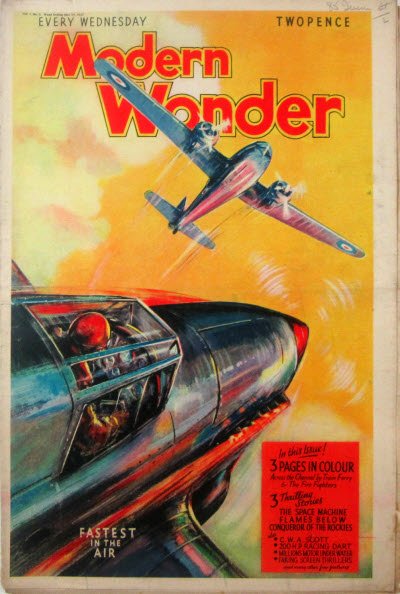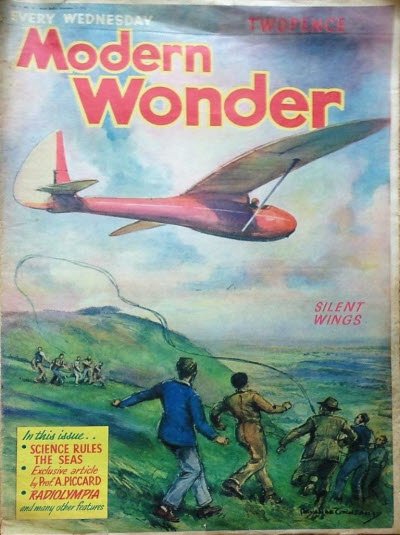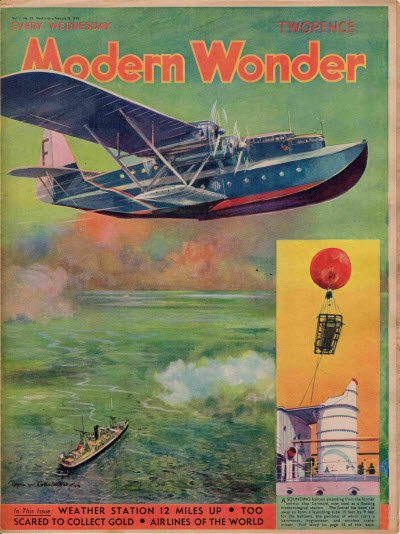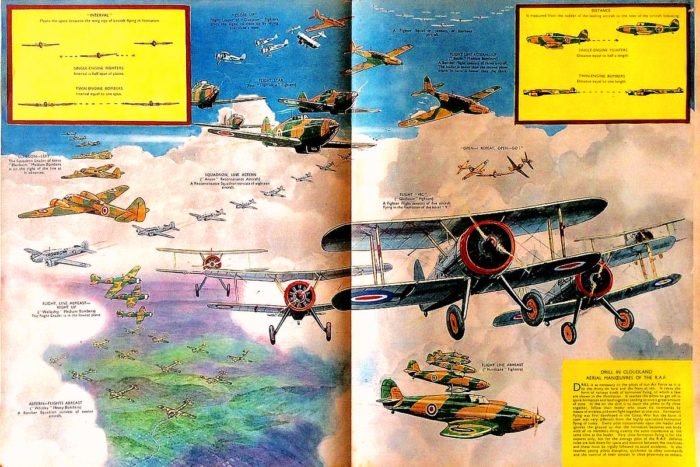
For nearly four years from May 1937, Modern Wonder (Modern World from March 1940) was a British weekly magazine, priced at 2d. and aimed at, presumably, boys and young men who were interested in high technology, big machines and vehicles that go really, really fast — sometimes fantastical, but mostly real, if on or near the bleeding edge. There don’t seem to be any full issues online, but you can get a feel for the content at Blimey!, and from the issue indices (and the covers!) at Galactic Central. Every issue seems to have been filled with battleships, spaceships, airships, etc. So, something like the American Popular Mechanics or Modern Mechanics , etc, or a more down-to-Earth Electrical Experimenter. Which is interesting, because this publishing niche wasn’t filled to anything like the same extent as in the United States.
The covers, which I’m looking at here, are similarly both quite vivid but not quite as over-the-top as their American equivalents. Of course, a significant number (though not the majority) were aviation-themed. The above, from the 19 May 1938 issue, showing an unmarked Armstrong Whitworth Whitley tangling with a balloon barrage, is reminiscent of Dare-Devil Aces, but unfortunately (for me, anyway) is the only battle scene I can find. Here are the other covers featuring aviation prominently, along with the title of what seems to be the relevant story (which doesn’t always exist). Feel free to jump in and tell me where I’m wrong!

29 May 1937: ‘FASTEST IN THE AIR’. What’s going on here? The ‘fastest in the air’ at this point was the Hughes H-1 Racer, which is neither of these. The twin-engined aeroplane could be a Bristol Blenheim. In 1935, its immediate ancestor, the Type 142, was very fast, by 1938 when the Blenheim, went into service, it wasn’t. Or is the intercepting interceptor the ‘fastest’?

19 June 1937: ‘New York Non-Stop’. Though the empennage is slightly different, this looks like a de Havilland Albatross, which made its first flight in May and was designed for transatlantic operations. Of possibly greater interest is what’s below: a combined seadrome and floating dock.

17 July 1937: ‘RIDING on the FOOTPLATE of the “SILVER LINK“‘. The focus here is on the train (from the same class as Mallard); it’s not clear if the aeroplane is part of the same story or is just there to make the cover ((even) more) exciting. Looks like an Airspeed Oxford, which again made its debut flight the previous month.

14 August 1937: ‘THE EARS OF THE AIR FORCE’. There’s a line of Blenheims at the top, oddly in very distinctively non-military colours. But the point of this cover is the sound detector (and the searchlight) at the bottom. Your Territorial Army at work.

28 August 1937: Malcolm Burr, ‘The Great African Conquest’. This is an easy one, a Short Empire, specifically the first of the class, G-ADHL, Imperial Airway’s Canopus. It flew the first scheduled Southampton-Durban in June, which is presumably the subject of the article. Not sure what Malcolm Burr’s connection was, but if he’s the the geologist and entomologist who wrote a book about Angola then perhaps he flew on it. His daughter was airminded enough: Gabrielle Patterson, Britain’s first female flight instructor and part of the original intake of the Air Transport Auxiliary.

4 September 1937: J. Hurren, ‘Silent Wings’. Gliders are not my thing but for this I’m going to guess that it’s a Slingsby T.6 Kirby Kite. No idea who Hurren was!

9 October 1937: H. C. Skinner, ‘Air Thrills for a Living’. A classic hero shot of a Spitfire, or it would be if it was actually a Spitfire. There’s an intake under the propellor and the canopy looks elongated, so I’m going with the Fairey Battle, which went into service in June. (At least it’s not a Defiant.)

20 November 1937: Selby Lewis, ‘Flying Fortresses‘. Well, this one is easy enough, though based on the waist blisters they are Model 299s, not production B-17s. Selby Lewis seems to have been Modern Wonder‘s aviation correspondent, but I can’t find anything about him.

11 December 1937: ‘THINGS TO COME’. An obvious reference to the film released earlier that year, though rather more pacific in tone. Forget the airliner, the star here is the airport spanning the Thames. If I’ve got my geography right (and, sadly, it’s been a while and is likely to be a good while longer), this is built over Hungerford Bridge, with the point of view facing eastish, with the Embankment running along the river and St Pauls in the upper left. That would make it very convenient for Embankment and Charing Cross stations, and only a short walk from Westminster. I can’t find any reference to a Hungerford Bridge Airport with a quick search, but ideas like this were pretty common in the 1930s.

8 January 1938: ‘100 Miles Above the Earth’. This will be Jean Piccard’s cluster balloon Pleiades. (His twin brother Auguste wrote an article on ‘Exploring Space’ for the September 1937 issue.)

15 January 1938: ‘OVER TEN MILES UP’. Easy (because it says so on the cover!): the Bristol Type 138 High Altitude Monoplane, which made its last record flight in June 1937.

5 February 1938: Selby Lewis, ‘The World’s Wonder Baby Planes’. Whatever is going on here, do not try this at home.

12 February 1938: ‘WEATHER STATION 12 MILES UP’ / ‘AIRLINES OF THE WORLD’. F is for Francais: a Latécoère 521. And what looks like a very advanced radiosonde.
19 March 1938: Selby Lewis, ‘Balloons to Trap Air Raiders’. This is the one at the top of the post. There’s a quite a few more to come, so I’ll stop here for now. But here’s a bonus! Via Trevor Clark, a spread from the 7 May 1938 issue, entitled ‘Drills in Cloudland’:

![]() This work is licensed under a Creative Commons Attribution-NonCommercial-NoDerivatives 4.0 International License.
Permissions beyond the scope of this license may be available at http://airminded.org/copyright/.
This work is licensed under a Creative Commons Attribution-NonCommercial-NoDerivatives 4.0 International License.
Permissions beyond the scope of this license may be available at http://airminded.org/copyright/.



“J. Hurren” is probably “B. J. Hurren,” Flight’s dumbest freelancer of the early postwar era. He joined the Fleet Air Arm during the war, produced some error-ridden ephemera, and joined (I think, I’d have to check my notes to be sure), Fairey’s publicity department after the war, and was heavily involved in the pr for the 1949 Farnborough show.
Oh, and he also wrote about learning to drive and modelling the Battle of Waterloo.
Great stuff Brett, all new as a magazine to me, and I agree on the relative rarity in the UK compared to the US as a niche.
Regarding the aircraft ID, there’s some quirks I can help with;
• I agree with the Whitley, interesting ‘turret’ type nose, very experimental then.
• The ‘Fastest in the Air’ could be a Blenheim, but it’s a stretch, while the fighter’s not a prototypical machine I can think of, and I like it.
• Yes, a de Havilland DH 91 Albatross, and the first type of empennage correctly rendered. This was changed in production to the more familiar endplate fins and rudders. The nose is awful though…
• Oxford – close (we’ve been here before!) the side windows make it an Airspeed Envoy, the Oxford’s civil predecessor.
• ‘Ears’ is interesting, I see a ‘US’ on the nearest port wing, and I think they’re meant to be USAAC Martin B-10s, and the cap on the middle chap could be meant to be a US Army style one (definitely NOT British, anyway). The USAAC and USN both had bright colours – though not these. That said, I agree regarding random bright colours, which, taking the point further, were widespread in this genre, and still seen on cheap toys as an eye-catcher for sales.
• Skipping onto ’Air Thrills’, it’s a riff on a cousin of the Battle, the unnamed Fairey P.4/34 (the 45 degree angle cut to the aerodynamic rudder balance is distinctive of, interestingly, the Battle and other Fairey aircraft, but not the P.4/34). This was a precursor to the Fairey Fulmar naval fighter, and was popular in illustration, as it was, like many other forgotten types of the thirties, heavily publicised at the time and seen at trade shows.
• ‘The Things to Come’ airliner, I agree should be overlooked, it’s another not-accurate DH Albatross.
• The car top landing seems to be a generic US Piper Cub-a-like, landing on a fastback Bentley! The ‘truck top landing’ is still an airshow staple, and I’ve seen it in the UK, US and Australia in the last couple of decades. Impressive, and with knowledgeable crews, not as hard as it seems, obviously!
And lastly, as we discussed on Twitter, the ‘Drills in Cloudland’ is a mix of the artist’s fantasy and the fantasies of the RAF about air combat. And that, as they say, is another story…
– James
The “Forts” are definitely 299s but I was taken aback by how Italian they look.
Erik:
I guess somebody had to be the dumbest? Looks like he was a Lt-Cdr, RNVR during the war, and as of 1951 the Royal Aero Club’s historian.
JDK:
Thanks for the corrections!
I think the ‘Air Thrills’ cover is actually a Battle rather than a P.4/34 – in fact I believe it is based on this photo or one from the same occasion (there were a sequence of photos showing the manoeuvre but this is the best known, and the only one I have a copy of) https://navalairhistory.com/wp-content/uploads/2024/08/img_20180524_2541.jpg
Found it! Here’s the photo of the Battle (probably K7558) that the 9 Oct 1937 cover was based on https://navalairhistory.com/wp-content/uploads/2024/08/k7558_staniland2.jpg
You’ve convinced me, Matt!